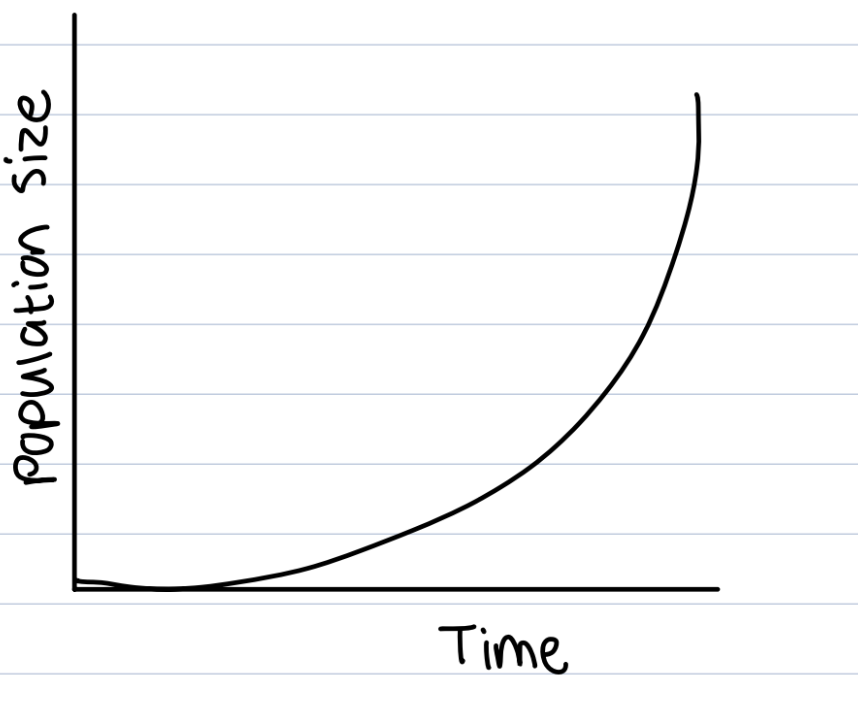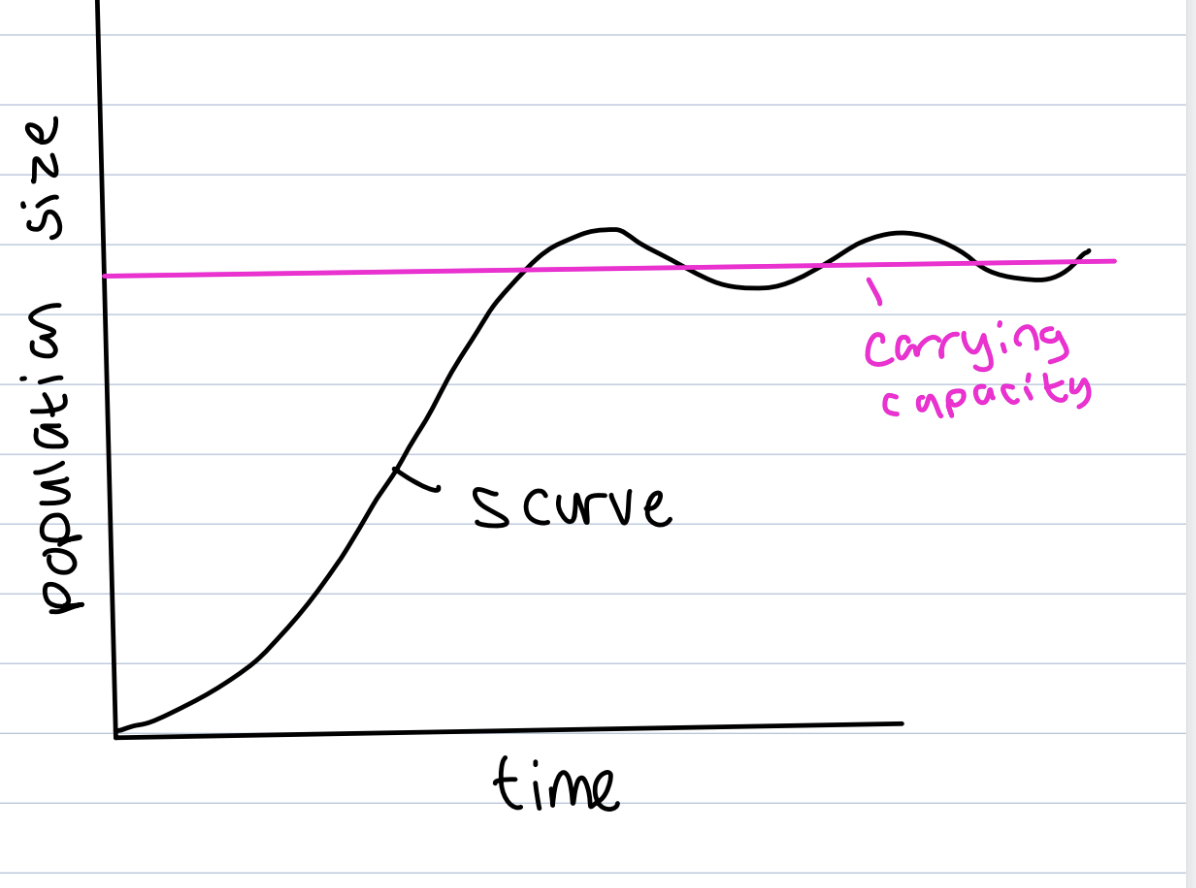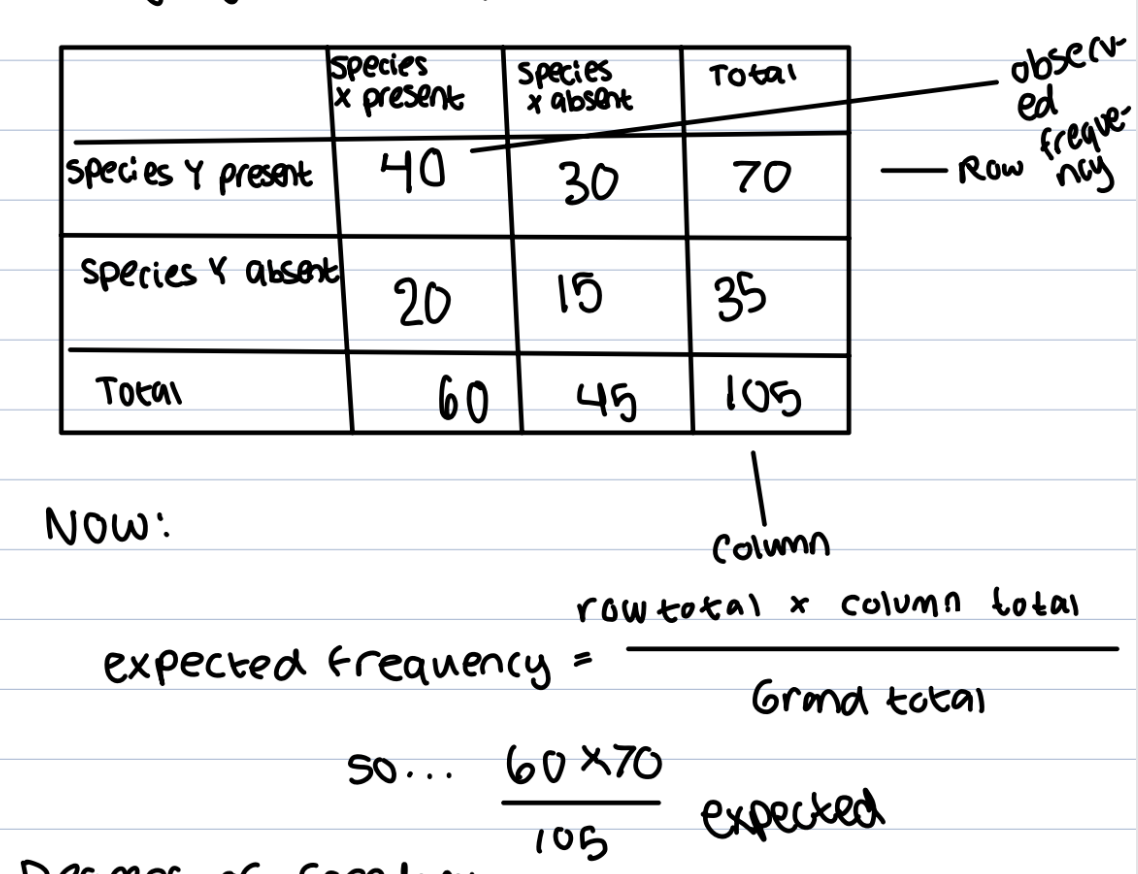c4.1
1/43
There's no tags or description
Looks like no tags are added yet.
Name | Mastery | Learn | Test | Matching | Spaced |
|---|
No study sessions yet.
44 Terms
Population
Group or organisms of the same species interacting in a given geographical area
Within 1 species
Populations can show variations due to geographical or environmental factors
Reproductive isolation
The inability of organisms of the same species to successfully breed due to geographical isolation, behavioural isolation or temporal isolation (timing of mating)
Distinguishes populations and restricts gene flow between organisms, leading to accumulation of different genetic variations, can result in speciation
Why estimating population size is needed
estimation population size is needed for understanding of species dynamics, assessing ecological health, conservation strategies
Random sampling
Unbiased selection of organisms→ each individual has an equal chance of being chosen
representative sample → estimate accurately represents overall population
Quadrat sampling
Technique used to study populations of sessile species (fixed to one location)
-quadrat used, square frame of known area is randomly placed over a section of habitat recored, measure number of organisms of interest falling in quadrat recorded
-Randomly place over sections of the study area, using random generator and GPS
—observer counts and record the number of organisms in each quadrat
-estimation of population sizes
-analysis of spacial distribution patterns in a population
-If organism is half in the quadrat, researchers must establish a constant counting criterion
-data consistency, reliable data collection accurate estimations and analyses of populations
Another form of quadrat testing
-Capture images of habitat under study and overlay a grid on the photo
-each square represents a virtual quadrant of known area
-Useful for studying organisms difficult to access (In situ, method occurring in species natural habitat)
Sample appropriate number of quadrants across an area
habitats with high diversity or rare species may need more quadrants
mean number of organisms per quadrant is calculated by adding up counts and dividing by total number of sampled quadrants
mean value used to estimate population size
Estimating population size for motile organisms M x N/R
Capture- mark - release - recapture method
Capturing a significant sample of population
marking them in a way that does not harm their survival
release back into population
interact naturally in habitat
period of time passes
second sample collected
number of marked vs non marked individuals recorded
M= number of individuals captured and marked in first sample
N= Total number of individuals captured in second sample
R= Number of recaptured individuals already marked
Assumptions and limitations Lincoln method
-Marking technique has no influence on behaviour of organism
-Marked individual has same chance of being chosen and captured again as unmarked
-no birth death etc during study period
-studied individuals are representative of entire population
-Increased accuracy by increasing populations sizing and increasing repeats
Carrying capacity what is it and what is it influenced by
Maximum population size that a given environment can sustain over a period of time
influenced by availability of resources that play a role in determining number of individuals or species an ecosystem can support
Carrying capacity dynamic
Varies over space and time depending on abundance of limiting resources
not based on availability of one resource but by combination of limiting factors
when resources like food/water/space are limited, competition increases between everyone who needs it
Population density
Number of individuals per unit area or volume
how closely packed individuals are within a given space
size of population influenced by density dependent and independent limiting factors
Density dependent factors what are they and give examples
have a greater impact on population size as population density increases
factors are- competition for resources, predation, disease
increasing population, decreasing availability of resources, increasing competition
increasing competition, decreasing reproduction success rates, decreasing growth rates
Increasing population density, increasing spread of disease, increasing likelihood of predation, decreasing growth
Negative feedback mechanism
Density dependent factors act as negative feedback mechanisms, regulating population size, keep it closer to carrying capacity of environment
Fluctuation in population size helps retain relative balance in ecosystem, survival of both predator and prey species
Density independent factors
Impact on population regardless of its density
causes sudden and drastic changes
like floods, droughts, hurricanes
destroys habitats- effects survival rates of individuals
anthropogenic events like deforestation, urbanisation, pollution, climate change (human caused) disrupts population dynamics
impacts availability of resources, changing ecosystem carrying capacity
population exponential growth
J shaped curve, occurs in populations under ideal conditions when resources are unlimited, abiotic factors are favourable
Pattern normally seen in bacteria

Exponential growth in natural ecosystems
Limited by amount of nutrients, competition for resources, predation
prevents sustained exponential growth
expectation of unlimited resources and maximum reproductive capacity is unrealistic
Sigmoid growth in environments with limited resources
population first has exponential growth when resources are abudnant and low competition
when population keeps increasing, density dependent factors come into play, limiting rate of population growth, scarcity of resources leads to increase of competition and decreased growth rate
population reaches equilibrium at carrying capacity when birth rate= death rate

To graph population growth
Use logarithmic scale for y axis, population size, use non logarithmic scale on x axis time, scale logs compresses data, easier to observe patterns and trends
non logarithmic scale for time representation
Duckweed experiment
collect population growth data using yeast or duckweed, rapid growth under controlled experimental conditions
establish a population in a suitable growth medium, record population of yeast in suitable growth medium over time intervals
Intraspecific interactions
Interactions occurring between individuals of the same species
interactions competition and cooperation
Competition-
Male lions who compete for dominance and access of resources
population of birds, in competition for nesting sites and territories decreasing their breeding success and density
individuals of same species compete for limited resources leading to individuals adapting to special niches, displacement of less competitive individuals, regulation of population size
cooperation-
individuals collaborate to increase chances of survival and reproduction
-social amoeba which when they are starving , individual amoebas aggregate to form multicellular structure protects and allows them to obtain and share nutrients
-In a bee colony, bees work together in a highly organised manner, each with a specific job
Communities
diverse array of populations within a specific area ranging from plants, animals, fungi, bacteria
Interspecific interactions
Relationships that occur between different species within an ecosystem
ecological interactions below
Herbivory
Fundamental feeding relationship when a herbivore consumes plant material as its primary nutrient source
occurs with the giant panda and bamboo plants
giant panda adapted to feed exclusively on bamboo, relying on its nutrient value
evolved specialised traits to effectively extract nutrients from plants
Predation
Predator captures and consumes its prey
grizzly bears and salmon
grizzly bears as predators rely on salmon prey for a source of energy
predation shapes behaviour, population size, reproductive success of salmon
Interspecific competition
Different species compete for limited resources within an ecosystem
implications on species distribution, abundance, evolution of traits due to acquiring resources
Eastern Grey squirrels and American red squirrels in North America
Compete for similar food resources, affects growth and survival of populations
Parasitism
Symbiotic interaction when one organism, the parasite, benefits at expense of its host
parasite lives on or within the host taking nutrients and resources leading to harm
tapeworms live in the intestines of host organisms, absorbing nutrients from they digestive systems
evolved adaptations to exploit hosts while minimising damage causing death
Pathogenicity
Pathogen is a micro-organism like a virus, bacteria, or fungus capable of causing disease in its host
Invade and multiply within host’s tissue and disrupt physiological functions
Direct and immediate detrimental effect on host
spread easily host to host
influenza viruses
Mutualism
Symbiotic interaction (between two different organisms) here both parties obtain benefits from the relationship
root nodules in Fabaceae mutualism
root nodules in Fabaceae-
Legume plants in the fabacecae family
contain root nodules filled with nitrogen fixing bacteria which convert atmospheric nitrogen into a usable form
bacteria provide legume with nitrogen, plants provide bacteria with carbohydrates/compounds for growth and survival
Mycorrhizae in Orchidaceae
mycorrhizae in Orchidaceae-
specialised mycorrhizae fungi colonise orchid roots
fungi aid orchids with getting nutrients by extending their hyphae into soil, increasing surface area for nutrient absorption
orchids provide fungi with organisms compounds produced through photosynthesis
Zooxanthellae in hard corals
-Photosynthetic algae called zooxanthella live in tissues of hard corals
-provide coral with essential nutrients from photosynthesis that help coral growth and reproduction
-provide coral with vibrant pigment to protect them from excessive UV radiation
-coral offers a sheltered environment and access to sunlight for photosynthesis
Invasive species
-introduced to new environments where conditions are favourable for them to rapidly establish and spread unlike native species
highly effective use of resources
leads to rapid decline or extinction of endemic species (naturally found in specific region)
competitive advantage in resource acquisition over endemic species
Invasive species killer algae
killer algae native to indian ocean introduced to Mediterranean sea
algae secretes a toxin that deters molluscs, herbivorous fish, sea urchins
lacks natural predators outside its native range
in its new habitat it competes with native marine plants forming dense mats
smother and displace native species
rapid growth and absence of predators
allows it to spread and lower native biodiversity
Testing interspecific competition
To assess the impact of a species remove it from the community
researchers can closely observe responses of remaining organisms- shows impact of competition on distribution and success
success of another species in absence of one can show interspecific competition
correlation does not offer definitive proof
can use laboratory experiments to provide controlled conditions, then manipulate a variable to show effect on success of species
can use field observations using random sampling, allowing researches to get data on species abundance and distribution, can show potential competition
Chi squared test which tests can we use
Determine whether there is a significant association between 2 categorial variables
association between presence of 2 species?
does the relationship between 2 species occur due to chance?
test of independence
use quadrant sampling- 2 species are associated with each other they will be found within the same quadrants
negative association arise due to competition for same limited resources (interspecific competition)
steps of chi squared test
2 hypothesis established
-null hypothesis: distribution of species X and Y is not associated
-alternative hypothesis: distribution of species X and Y is not associated
test only valid if frequency Is five or larger and sample is taken randomly from population
use a contingency table to input observed values
do expected frequency = row totalxcolumn total/ grand total
calculate degrees of freedom- (number of rows in the table-1)( number of columns - 1 )
Using degrees of freedom plug in table and determine critical region like 0.05 (p) probability, look what its value is for your degrees of freedom (critical values)
calculate X² = sum of (O-E)²/E
o= observed frequency e= expected
compare this value with the critical value, if it is higher than the critical value we can accept null hypothesis and reject alternative, if it is lower we can accept alternative and reject null

limitations chi squared test
Must have a large sample size but not too large to where it takes forever
can only determine a statistical association not a casual relationship
doesnt account for outside factors influencing results
control of populations
regulation of size and growth of populations in an ecosystem
maintain balance and prevent detrimental effects like resource depletion and overexploitation
Density dependent control
Predators play a role in regulating prey populations
predator- prey relationships are an example of animal populations being regulated by density dependent factors and negative feedback
predator populations increases, increased predation, increased pressure on prey, decrease in prey numbers, decrease in food availability for predators and decrease in predator numbers- fluctuation cycle of population regulation
ex. interaction between cheetahs and gazelles
increased population of gazelles, increased food availability for cheetahs, increased population of cheetahs, increased predation pressure on gazelles, decrease in gazelle population, decrease in food supply for cheetahs, decreased cheetah population
top down control
abundance/behaviour of lower trophic levels in a food chain is regulated by presence and activities of organisms at higher levels
consuming and limiting abundance of their prey; predators shape structure and dynamic of lower trophic levels
bottom up control
availability of resources at lower trophic levels influences abundance and distribution of organisms at higher trophic levels
factors like nutrient availibility, climatic conditions, primary productivity, exert bottom up control
in a terrestrial ecosystem, avialibilty of soil nutrients determine growth of plants and the abundance of herbivores that rely on them for food
both of these are possible, but one is more likely to be dominant in a community
allelopathy and antibiotic secretion
2 processes in which organisms release chemical substances into their environment to deter competitors
example allelopathy
black walnut tree, releases a chemical compound called juglone into soil, acting as a potent inhibitor, suppressing growth of nearby plants, inhibits key physiological processes in competing plants, creates zone of reduced plant diversity around it
example antibiotic secretion
streptomyces bacteria; found in soil/marine environment, ability to synthesise range of antibiotics like streptomycin acting as a defence mechanism giving it a competitive advantage
can be used as medicine to treat bacterial infections as it acts as a defence